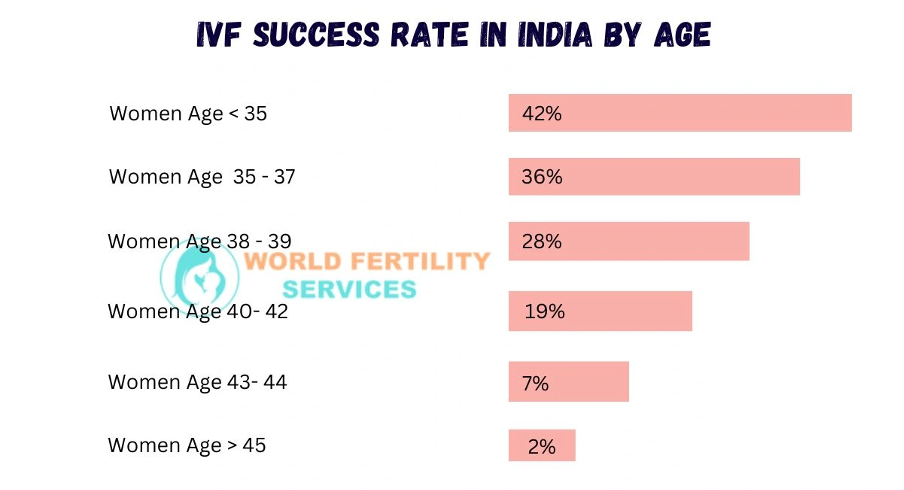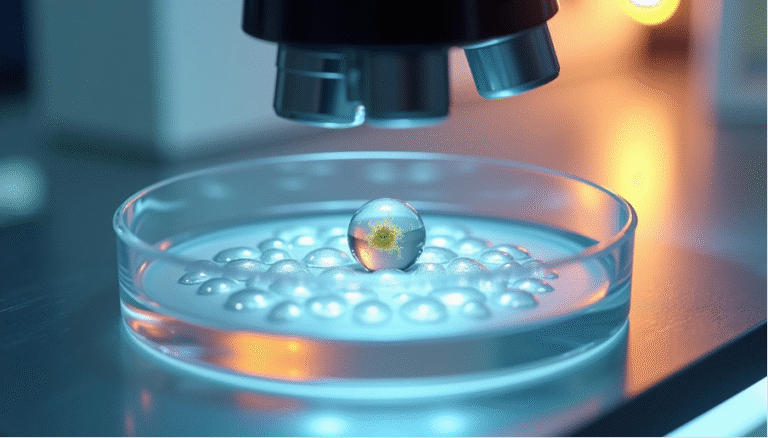IVF success rates in India range from 30% to 50% per cycle. These rates show big differences based on age. Women under 35 can achieve success rates up to 52%. The rates drop to less than 20% for women over 40. Age makes the biggest difference in IVF outcomes. Better egg reserves and quality help women under 35 achieve live birth rates around 51.1%. The chances of success drop by a lot with age. They fall to about 20% at age 40 and go down to 8% by age 43. These age-based success rates can help you set realistic expectations during your IVF experience.
In this piece, we’ll look at what really affects the average IVF success rate in India. We’ll go beyond age to find other factors that shape your chances of successful conception. The number of embryo transfers, clinic’s resilient infrastructure, and your health all play key roles in determining your success chances.

Understanding IVF Success Rate in India
Specific metrics help us measure how well fertility treatments work. IVF success rate shows the number of IVF cycles that achieve positive outcomes. This measurement varies among clinics and patients, so it’s worth mentioning that these numbers need careful interpretation.
Definition of IVF success rate per cycle
Fertility specialists look at the percentage of IVF procedures that achieve desired outcomes. Clinics might report several metrics, but live birth rate remains the most meaningful measure. This tells us how many patients actually take home a baby. Other measures like implantation rates or chemical pregnancy rates don’t always mean a baby will arrive.
Average success rate of IVF in India (30%–50%)
IVF success rates in India match up well with global standards. Indian fertility clinics report success rates between 30% and 50% per cycle. First attempts usually succeed 20% to 35% of the time, and the chances improve with more cycles. Patients under 35 see success rates of 50-60%, though these numbers drop as age increases.
Difference between clinical pregnancy and live birth rate
The difference between pregnancy outcomes helps patients set realistic expectations. These success metrics include:
- Biochemical pregnancy: Shows up as positive on pregnancy tests but might not develop further
- Clinical pregnancy: Ultrasound confirms a gestational sac or heartbeat in the uterus
- Live birth rate: One or more babies arrive safely – the ultimate goal
The loss rate from clinical pregnancy to live birth stands at about 19%. This means not every confirmed pregnancy results in a baby. Patients should look for clinics that openly share their live birth rates rather than just clinical pregnancy rates. Clinical pregnancy rates alone can paint an overly optimistic picture.

Image Source: World Fertility Services
IVF Success Rates by Age Group
A woman’s age plays the most crucial role in determining IVF success. Success rates show a clear pattern that fertility clinics in India have documented extensively.
Under 35: 50%+ success rate with own eggs
Women under 35 see the best IVF results, with success rates between 50% and 60% per cycle. Their high ovarian reserve and excellent egg quality give them these impressive outcomes. The total live birth rate reaches about 51.1%, which makes this the best age to try IVF. Young women in their 20s maintain these high success rates even with challenges like low egg count or genetic disorders.
35–37: Decline begins, success around 30–35%
Success rates start to dip after age 35. Women in this age group can expect success rates between 30% and 35% per cycle. The total live birth rate drops to 38.6%, showing a slight decrease from younger patients. In spite of that, many women still get pregnant within their first few cycles, especially with proper medical care.
38–40: Further drop, success around 20–25%
Success rates fall more sharply between ages 38-40, reaching about 20-30% per cycle. The total live birth rate decreases to 24.8%, which shows a steeper decline than earlier age groups. Egg quality becomes a bigger concern during this time and can affect embryo health and implantation rates.
Over 40: 10–15% success, donor eggs often recommended
Success rates drop significantly after age 40. Women see about 15-20% success at 40, which falls to 12% by 42 and goes below 5-10% after 45. Doctors often suggest using donor eggs at this stage. Eggs from younger donors boost success rates to 60-70%, whatever the recipient’s age might be, since donors are usually between 21-34 years old.
Also Read:What Is Infertility? Common Causes, Signs & Treatment Options
Impact of Embryo Transfer Count on IVF Outcomes
The success rates and health risks of IVF cycles depend on the number of embryos transferred. This decision shapes the entire treatment journey and requires careful consideration of both pregnancy chances and possible complications.
Single Embryo Transfer (SET) vs Multiple Embryo Transfer (MET)
SET places one embryo in the uterus, while MET uses two or more embryos at once. These approaches show different success rates and risk levels:
- SET achieves 40-50% success rates per cycle
- Two embryos with MET boost success to 55-65%
- Sequential SET combines fresh and frozen transfers to reach live birth rates of 47.9%, matching MET’s success without extra risks
Many first-time IVF patients think MET gives them the best shot at success. The numbers tell a different story – SET’s success rate of 32.4% compares well to MET’s 47.1% in patients with good prospects.
Risks of multiple pregnancies with MET
MET leads to more twin and triplet pregnancies, which brings serious health risks:
- Twin rates are seven times higher with MET than SET
- Almost 60% of twins and 90% of triplets arrive early
- Twin pregnancies make maternal death rates four times higher
- Mothers face higher risks of preeclampsia, gestational diabetes, hemorrhage, and cesarean delivery
Babies born from multiple pregnancies often have low birth weights. They need longer NICU stays and face higher risks of developmental delays or chronic conditions.
Elective Single Embryo Transfer (eSET) for younger women
eSET lets patients choose to transfer one embryo when they have multiple options. The results are impressive:
- Live births reach 41.3% compared to 32.6% with double embryo transfers
- Multiple births drop to just 1-2%
- Women under 35 with quality embryos see the best results
Medical groups like ASRM strongly support eSET, especially for patients under 35 who show promising signs.
Key Factors That Determine IVF Success in India
Many factors beyond age and embryo transfer affect IVF success rates in India. These range from clinic facilities to personal health markers, and each plays a vital role in treatment outcomes.

Clinic infrastructure and lab technology
The clinic’s infrastructure quality shapes IVF results. Well-known fertility centers with modern lab equipment, skilled embryologists, and international protocols show better success rates. The lab environment must maintain perfect temperature, humidity, and air quality to create ideal conditions for embryo growth. Modern facilities also follow strict quality protocols for embryo culture, assessment, selection, and preservation methods.
Egg and sperm quality
Good gamete quality builds the foundation of successful IVF. Between 30-50% of infertility cases come from male factors. Sperm quality issues like low count, poor movement, and DNA damage directly affect outcomes. Healthy sperm count should be at least 39 million per ejaculate. Egg quality drops after age 35, which affects genetic makeup and overall viability.
Uterine health and endometrial thickness
A receptive endometrium is key to successful implantation. Research shows that endometrial thickness is a main predictor of live birth rates. Measurements under 7mm lead to much lower pregnancy rates. Ultrasound scans reveal that both thickness and pattern (triple-line vs. homogeneous) affect clinical outcomes independently.
Lifestyle factors: BMI, smoking, alcohol, stress
Daily habits shape fertility treatment results. Smoking harms sperm quality and damages eggs. Alcohol changes hormone production and reduces ovarian reserve markers. Research shows couples with four bad lifestyle habits achieved only 38% conception rates compared to 83% for those with none. Being underweight or overweight disrupts hormonal balance and affects IVF success.
Use of advanced techniques: ICSI, PGT-A, FET
Special procedures improve outcomes for tough cases. Preimplantation genetic testing (PGT-A) helps find chromosomally normal embryos and stabilizes success rates across age groups. Women over 40 maintain steady success rates around 48% with PGT-A, compared to lower rates with untested embryos. Techniques like intracytoplasmic sperm injection (ICSI) help overcome male fertility issues, while endometrial receptivity analysis finds the best transfer timing.
Also Read: How IVF Process Works: A Simple Guide for First-Time Patients
Conclusion
Knowing what affects IVF success rates will help you make better decisions about your fertility trip. Age is without doubt the main factor that determines success. Women under 35 have over 50% success rates, but this drops to less than 15% after 40. There are other factors that affect your chances of success by a lot.
The number of embryos you transfer in each cycle changes both success rates and risks. Multiple embryo transfers might give slightly better chances, but they can lead to complicated multiple pregnancies. Young patients with good-quality embryos are better off with single embryo transfers.
Your choice of clinic plays a vital role in IVF outcomes. Better lab technology, skilled embryologists, and strong quality control relate to higher success rates. On top of that, your personal health matters – things like egg and sperm quality, endometrial thickness, and lifestyle choices affect your treatment results.
New techniques help improve success rates for specific fertility problems. Preimplantation genetic testing helps maintain good success rates even for older women. Special procedures like ICSI work well to fix male fertility problems.
Your IVF trip depends on all these factors working together. It helps to set realistic expectations based on your age, health, and treatment plan. This prepares you mentally and emotionally. Success rates vary among different groups of people. Understanding these factors helps you work with your fertility specialist to create the best plan for you. Look for clinics that openly share live birth rates instead of just clinical pregnancies. This will give you a clear picture of your chances to take home a baby.
Key Takeaways
Understanding IVF success rates in India helps couples set realistic expectations and make informed treatment decisions based on scientific evidence and personal factors.
- Age is the primary factor: Women under 35 achieve 50%+ success rates, dropping to 30-35% by age 37 and below 15% after 40
- Single embryo transfer is safer: While multiple embryos slightly increase success (55-65% vs 40-50%), they dramatically raise twin pregnancy risks and complications
- Clinic quality matters significantly: Advanced lab technology, skilled embryologists, and quality protocols directly correlate with higher success rates across all age groups
- Lifestyle factors impact outcomes: Smoking, alcohol, poor BMI, and stress can reduce success rates by up to 45% compared to healthy lifestyle choices
- Advanced techniques boost success: PGT-A genetic testing maintains 48% success rates even for women over 40, while ICSI effectively addresses male fertility issues
The combination of these factors, rather than any single element, determines your individual IVF success probability. Choosing clinics that report transparent live birth rates and addressing modifiable lifestyle factors can significantly improve your chances of taking home a baby.
FAQs
Q1. What is the average IVF success rate in India? The average IVF success rate in India ranges from 30% to 50% per cycle. However, success rates vary significantly based on factors like age, with women under 35 having the highest chances of success at around 50-60%.
Q2. How does age affect IVF success rates? Age is the most critical factor in IVF success. Women under 35 have the highest success rates of over 50%, which decline to 30-35% for ages 35-37, 20-25% for ages 38-40, and below 15% for women over 40.
Q3. Is transferring multiple embryos better for IVF success? While transferring multiple embryos slightly increases success rates (55-65% vs. 40-50% for single embryo transfer), it also significantly raises the risk of multiple pregnancies and associated complications. For many younger patients, elective single embryo transfer is often recommended as a safer option.
Q4. What role does clinic quality play in IVF outcomes? Clinic quality significantly impacts IVF success rates. Advanced laboratory technology, skilled embryologists, and stringent quality control protocols directly correlate with higher success rates across all age groups.
Q5. Can lifestyle factors influence IVF success? Yes, lifestyle factors can greatly affect IVF outcomes. Smoking, alcohol consumption, poor BMI, and high stress levels can reduce success rates by up to 45% compared to patients with healthy lifestyle choices. Addressing these modifiable factors can significantly improve your chances of IVF success.
Disclaimer: This article is for informational purposes only and does not constitute medical advice. Always consult with a qualified healthcare provider for personalised guidance regarding fertility treatments





